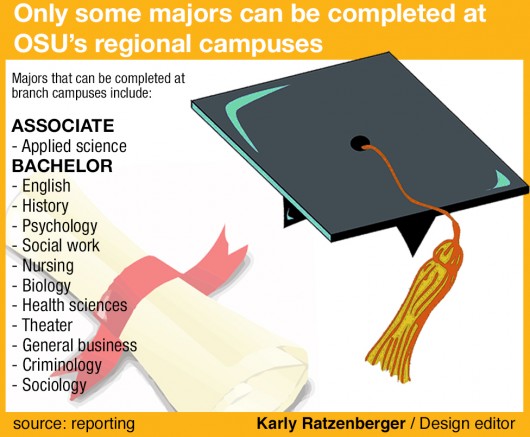
Though all diplomas earned at the five regional campuses — Agricultural Technical Institute (Wooster), Lima, Mansfield, Marion and Newark – read “The Ohio State University,” students at branch campuses have far less degree options than students at the Columbus campus, who have access to more than 175 majors.
Alexis LaRoche, a fourth-year in English, plans to graduate from the OSU-Marion this December, she said.
“I personally love OSUM (OSU-Marion),” she said in an email. “I wouldn’t change the fact that I decided to go here in a million years. I love my professors, I love the small atmosphere, and I love knowing a lot of the people in my classes.”
However, some students undergo the process of campus change from a branch campus to the Columbus campus after completing 30 credit hours while maintaining a 2.0 GPA at their branch. One reason students switch to the OSU-Columbus campus is to finish their majors, university officials and students both said.
“It seems to me that more people are attending OSUM for one to two years and then transferring to either Columbus or a different university altogether to complete their major,” LaRoche said. “English majors are staying in Marion because that’s an option, but most people can’t do that because they can’t complete their major (here).”
There are seven majors that can be completed for a bachelor’s degree at OSU-Marion, including business, education and social work.
Brian Skoglund, a third-year in hospitality management, came to the Columbus campus from Newark this year.
“The majors are pretty limited overall (at branch campuses). (Newark is) a great place to go for your general education credit classes or other classes for the beginning of some majors, like engineering,” Skoglund said.
Unlike OSU’s other regional campuses, ATI is the only campus that offers an associate degree in applied science, said Frances Whited, OSU ATI spokeswoman.
Other majors Lima, Mansfield, Marion and Newark offer that can be completed in four years include history, psychology and social work.
Business administration is offered at those campuses as well, while the general business major is offered at Lima, Marion, Newark and Mansfield.
Mansfield offers sociology, too, while Lima offers majors in biology, health sciences and theater. Mansfield and Marion also have criminology majors, and nursing is offered at the Newark, Marion, Lima, Mansfield and Columbus campuses.
Students can also start coursework for any of OSU’s more than 175 majors but would have to change to the Columbus campus to finish the requirements for many of them.
Some of the majors offered at the regional branches have high unemployment rates, according to a 2013 study from the Georgetown University Center on Education and the Workforce. Recent graduates in English, history, psychology and sociology have unemployment rates above 9 percent. Majors in biology, education and general business have unemployment rates just above 7.5 percent. Theater had the lowest unemployment rate of the majors offered at branches at 6.4 percent.
Paul Sanders, an associate dean at the Newark campus, said English, history and psychology have been offered at the regional campuses for a couple of decades. These programs were offered at a time that “predates the concerns of unemployment,” he said.
Donna Hight, the chief student life and retention officer at Mansfield, said it is an ongoing process to offer more majors at the branch campuses.
“We’re in constant communication with Columbus to add more programs,” she said.
Some of the obstacles from expanding their major offerings are the cost and the number of facilities available, she said. More majors are expected to be offered at Mansfield within in the next two to five years, she said, including health sciences and environmental studies.
There is an approval process that must be followed to add a major to a regional campus, said Christine Trapp, an associate director of academic services at OSU-Marion.
“Approval is needed at various levels (department, college, university), the same way approval is needed for a new major on the Columbus campus,” she said in an email. “Close collaboration between faculty and staff on our campus with the respective department in Columbus is critical throughout the process.”
One particular area of interest for expansion at the regional campuses are majors in science, technology, engineering and math.
“Currently, because of the increase in demand for STEM-related majors, we are offering more courses and at more (advanced) levels in science and math,” Trapp said.
In particular, the engineering major has gained some traction at branch campuses, Sanders said.
“Engineering has been great partner for us,” he said.
The first two years of engineering can be completed at the Marion and Newark campuses while Lima offers just the first year.
Bryan Albright, the associate director of enrollment services at OSU-Lima, said he expects engineering to be added to the regional campuses “down the road.”
Each of the branch campuses shares facilities with a local community college, called its “collocated community college partner.” Mansfield is working with its partner, North Central State College, on providing a four-year engineering degree program, Hight said. Students would be able to take the first two years of engineering at North Central and then finish at OSU-Mansfield.
Hight stressed the value that regional campuses bring to the university.
“The regionals are a great opportunity,” she said. “Their tuition is more reasonable than at Columbus.”
Tuition at the regional campuses is $7,140 per semester for an Ohio resident, compared to $10,010 at the Columbus campus. For non-residents, regional campuses’ tuition is $22,856 per semester versus $25,726 at the main campus, according to the OSU Undergraduate Admissions website.
LaRoche said a degree from a branch campus isn’t remarkably different from one earned at the main campus.
“They (students from the Columbus campus) don’t realize that my diploma isn’t going to say ‘The Ohio State University-Marion Campus,’ it’s going to say ‘The Ohio State University,’” she said. “I have to defend myself when I say I go to OSUM because people think of it more as a community college and an easy degree rather then an OSU education.”
Albright, too, said OSU doesn’t distinguish between its branch campuses and main campus.
“We’re just one university with six different campuses,” he said.


